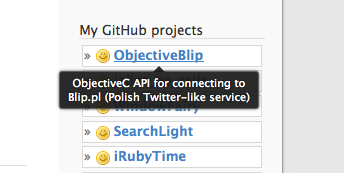I came across a problem recently. I have a project called xBlip which I’ve described before – it’s an iPhone client for a Polish Twitter-like service Blip. This project has a backend part which I keep in a subdirectory “ObjectiveBlip” and which I’ve tried to keep as separate from the rest as possible, with the intention that it might be one day extracted as a separate project.
Now I got the idea that I could write a desktop application for Mac that does the same – and of course I could reuse that backend part for that. I would also like to create a separate project on Github with just the backend, so that theoretically someone might use it in future for some purpose.
But this means that I would be maintaining three separate copies of the same code, which I’d have to keep in sync somehow. So the question is, how to do this best?
There are a few ways in Git to share code between projects (for example, git submodules) – but most of them are intended only for one-way communication, i.e. downloading updates to a library maintained by someone else into your project. Here, I want to have a two-way communication: I could extend the backend code while working either on the iPhone or the Mac application (working directly on the backend-only project wouldn’t usually make sense), and then broadcast the changes into the other two projects. I also don’t want the solution to be inconvenient to people who download the project, as is the case with git submodules – you have to manually update them once you download the main code, initially their directories are empty.
So I started looking for a way to pull this off – and I found a script called “git subtree” which seems to do exactly what I need (confusingly, there’s another plugin also called git subtree which is completely unrelated to the first one…). It took me some time (and a few emails to the author, Avery Pennarun) to figure out how to use it, so I thought I’d post a tutorial here in case anyone has a similar situation.
So, here’s what we need to do… (grab a coffee, it’s going to be long):
